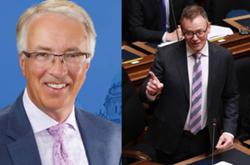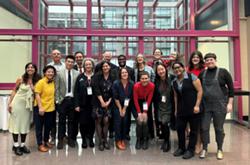
Most of us don't realize it, but one of B.C.'s most important exports is knowledge.
We don't load it onto freighters or trucks. We load it into the heads of about 28,000 foreign students every year, who then take it back home to China or Korea or the U.S. Doing so is making us a fortune.
Our export industries are alarmed by the rise of the Canadian dollar. God knows what's going to happen to the Vancouver film business, now that its members have to be paid in loonies costing more than U.S. greenbacks. American tourists, already discouraged by the need for a passport if they want to get back into the U.S., are likely to stay south of the border.
And what if we discourage those thousands of Asian, European, Latin American, and U.S. students who want to study here? Will that have an economic impact? It could, but we may have worse problems thanks to Ottawa.
Half billion dollars from international students
Surprisingly, StatsCan hasn't examined international students since 1996, but a 2006 study by Roslyn Kunin and Associates found that in B.C. we're doing very well out of them.
Kunin reported that international post-secondary students generate a lot of local jobs and pump astonishing amounts of money into the local economy. Direct spending by such students totaled a little over half a billion dollars. They created 6,000 jobs directly, and another 3,100 indirectly. Almost 5,000 of those jobs were in the government sector.
In the Metro Vancouver region, Kunin found that international students at just two schools -- Simon Fraser and Vancouver Community College -- generated almost $90 million in spending, creating 1,600 jobs in the process.
Canadian courses at a premium
As a Capilano College teacher, I know how much of my own bread is buttered by foreign students. They now make up 10 per cent of Cap's student population. Walk across my campus and you'll hear them yakking on their cell phones in Mandarin, Japanese, Korean, Farsi, Spanish -- and English. It's music to my ears.
They pay a huge premium to take our courses. A Canadian resident pays $312 for each 3-credit course at Cap College, or $3,120 for a year of full-time education. The international student in the next seat is paying $1,150 per course, or $11,550 for a year of university-transfer or career-program education -- almost three times what the resident pays.
In theory, these big fees cover the full cost of the foreign students' tuition, while the residents are heavily subsidized. In practice, foreign students are paying enough extra to subsidize their classmates and teachers. Many Canadian students would not be able to take a particular course, or enroll in a particular section, without the extra money that international students have provided to their schools' overall budget.
Recruiting K-12 students
Many school districts also recruit international students. This year, about 980 pupils are paying $12,000 each for a year's education in the Vancouver schools. Victoria pays Vancouver about $7,932 for each resident pupil, so the internationals are more than paying for themselves.
As you might expect, everyone is competing for overseas students. Education fairs are big business in Asia and Europe, where agents earn a percentage of the first-year tuition fee of each student recruited.
The international-student administrator in another Lower Mainland district wrote to me from Istanbul: "Turkey is a new market for our school district, and the presence of the Superintendent helps parents to understand the level of importance our school district places on the international student program. Just prior to Turkey, we attended an international education fair in Berlin to meet European recruiting agents and prospective students."
The administrator went on to say B.C. school districts have two strong assets: "The fact that Canada is currently ranked #2, with only Finland ranking higher, on Program for International Student Assessment (PISA) in the areas of reading, mathematics and science, while the U.S. is ranked much lower. "Secondly, the fact that Vancouver has been named the best, most livable city in the world based on quality of life, safety, health, recreation, and natural environment."
Can they afford us now?
Now a problem is looming for our education exporters. B.C. enjoys a good reputation, especially in Asia: Our schools are among the best in the world. Our cities are reasonably safe and clean. Our multiculturalism makes us both exotic and comfortable. But we've lost the big advantage of a weak dollar.
Comparison shopping could make us look less attractive to some foreign students. A year's tuition in arts or engineering at UBC, for example, costs $22,438. Converting that amount into US dollars (currently worth 94 cents) would produce $23,798. At the University of Washington's Seattle campus, tuition would cost only $22,131, leaving a foreign student with an extra $1,667.
At the community-college level, Canadian schools are still a bargain. A year's tuition at Cap College ($11,550) would convert to $12,250 U.S. -- but that year at North Seattle Community College would cost $14,903 in Canadian dollars -- obliging the foreign student to spend an extra $2,653.
Gary Henkelmann is the manager of Cap College's International Student Centre. When I emailed him to ask about these issues, he replied from Southeast Asia, where he was busy recruiting more students.
"I was afraid of how students and parents would approach me about it," he wrote, "but it has not been all that negative. They are used to the rise and fall of various currencies including their own, so the attitude, a little bit, is who knows what it will be like by the time my child has to pay tuition in 8-12 months, or even down the road assuming 4-5 years of costs.
"When one is paying $50,000 or more for overseas education, does a few thousand dollars mean much? In general, these are well-off people. Quality of programming is still very important. Most surprising of all is that the high Canadian dollar signifies a strong, robust country and economy so 'Canada must be a good place that is getting better.'"
Gordon McNeil, director of international education at Langara College, agrees. Just back from Japan and China, he says no one raised the issue of the rising dollar. "Canada is still perceived as a safe, secure and tolerant place for international students. My sense is that parents are willing to pay a premium for that benefit."
But he warns that "Lack of control of the private education sector has also given us headaches. The overseas media feed on the irresponsible and bogus private schools that have been set up in Canada and aggressively promoted overseas."
No national education strategy
The real problem, from Henkelmann's point of view, is that "Canada appears to people here as a disjointed country with no national educational strategy, where each province and school competes against the next, where there is little cooperation between CIC (immigration) and the education industry, and this 'disorganization' turns people to Australia, the U.K. and even the U.S.A."
McNeil is blunter: "We are likely our own worst enemy. The federal government has a hard time herding the 'provincial cats' into the same house. Provincial promotion is often anti-productive as national governments overseas struggle to deal with our juggernaut of educational systems and options."
Such views finds strong support from Globe and Mail columnist Marcus Gee, who recently reported from Ho Chi Minh City on how other countries are outdoing us in attracting foreign students.
Despite all our advantages, Gee observes, the Australians are beating us up. They put real resources into promoting their country as an education destination. So they get almost 10 per cent of all international students, while we get three per cent. Australia's growth in foreign-student enrolment between 1998 and 2004 was 169 per cent; ours was 14.8 per cent.
Maybe we can blame our constitution, which makes education a provincial responsibility. But Ottawa pays a big chunk of our post-secondary spending. The feds ought to understand that most Asian economies run on guanxi, personal relationships, that often form in school.
A Vietnamese or Chinese or Mexican alumnus of UBC or SFU is likely to be a senior manager of a company or government agency in just a few years. That manager's Canadian connections could result in contracts that would otherwise enrich the U.S. or Britain (or Australia).
From students to immigrants
What's more, the students we attract could become critically valuable immigrants. The Canadian Bureau for International Education, in a recent news release, reported that only a third of our international students plan to stay here to live and work. The rest see more opportunity back home or in the U.S.
Meanwhile, says the CBIE, the UK, Australia and New Zealand are working hard to keep the brain drain working in their favour. In New Zealand, a foreign grad can spend a year looking for work. Here, the grad has to find a job in 90 days, or go home.
In 1984 I returned from a teaching stint in China with a very strong sense of what Canada could achieve by promoting international education. Since then I've rejoiced in the foreign students who have transformed my small suburban college into a truly world-class, world-influential institution.
But after a quarter of a century we Canadians have still not seized the opportunity to become the world's best educators, the place where the smartest kids on the planet dream of going to school ... and then staying for the rest of their lives.
Related Tyee stories:
- Click-and-Drag Education
Dropping enrolment fuels BC Libs' push for online learning. - The Student Loan Crush
How it got so heavy, and how to lighten it. - How BC Libs Aim to Reinvent Higher Ed
'Campus 2020' report promises upheaval without progress.















Tyee Commenting Guidelines
Comments that violate guidelines risk being deleted, and violations may result in a temporary or permanent user ban. Maintain the spirit of good conversation to stay in the discussion.
*Please note The Tyee is not a forum for spreading misinformation about COVID-19, denying its existence or minimizing its risk to public health.
Do:
Do not: